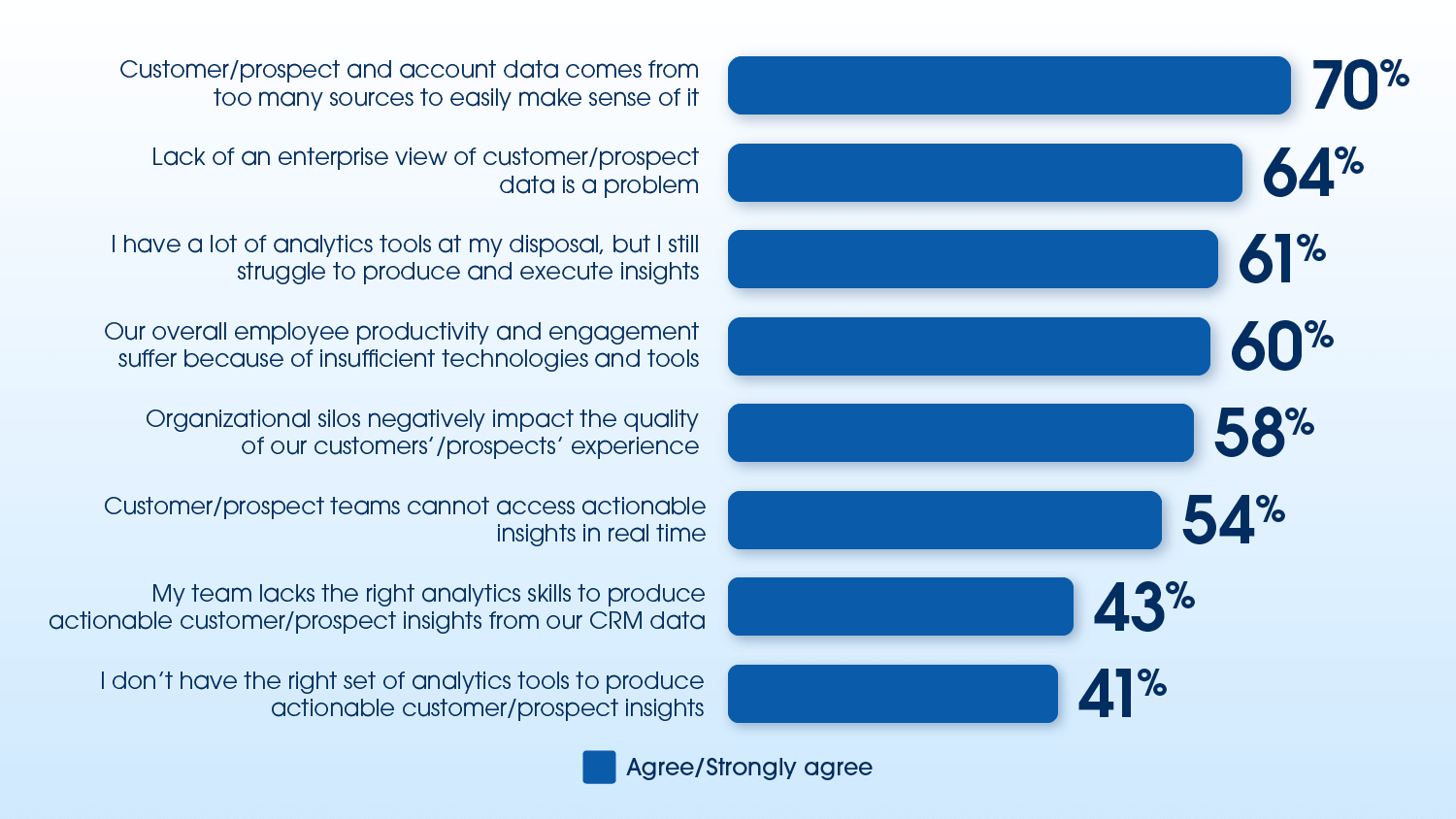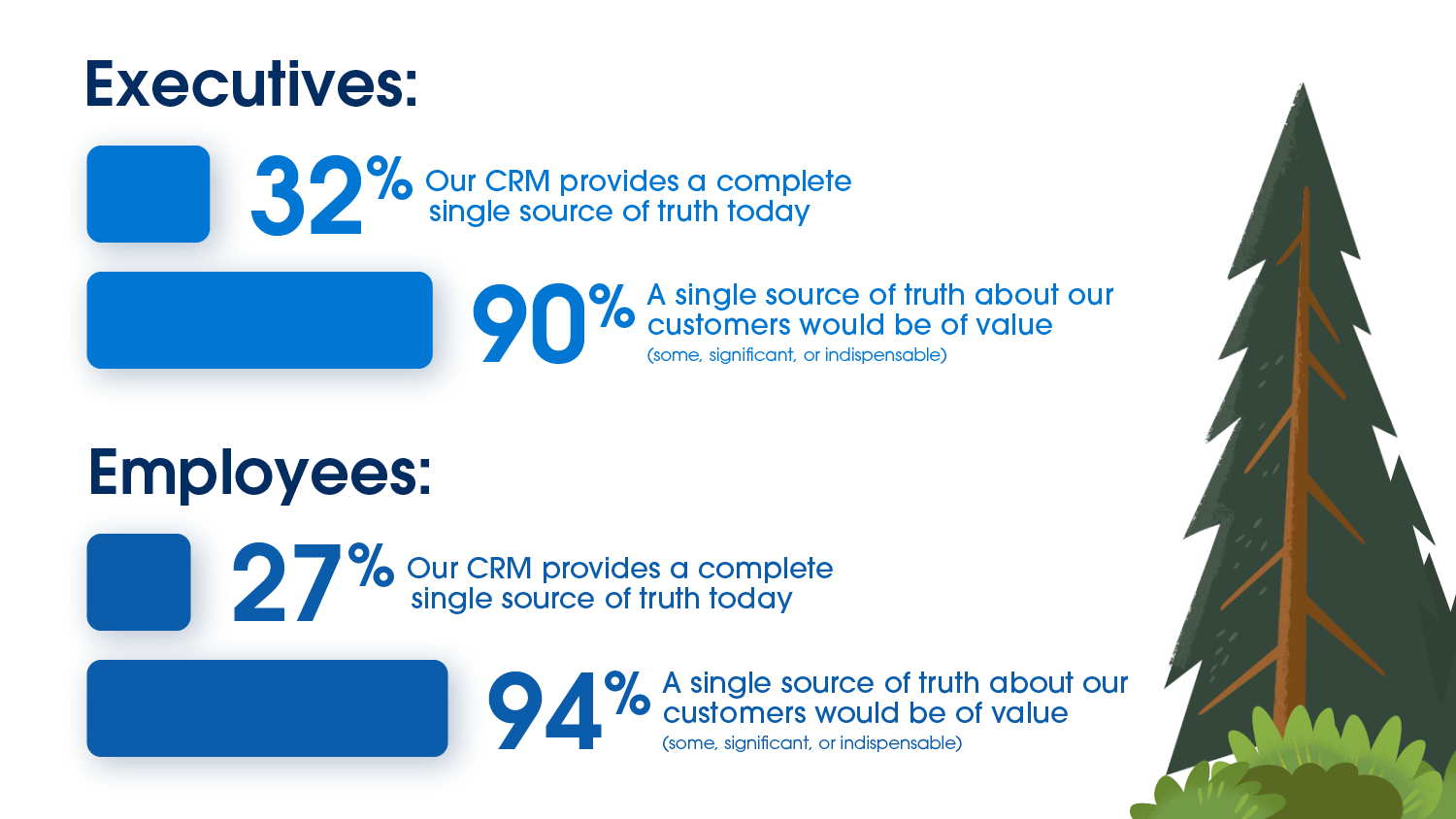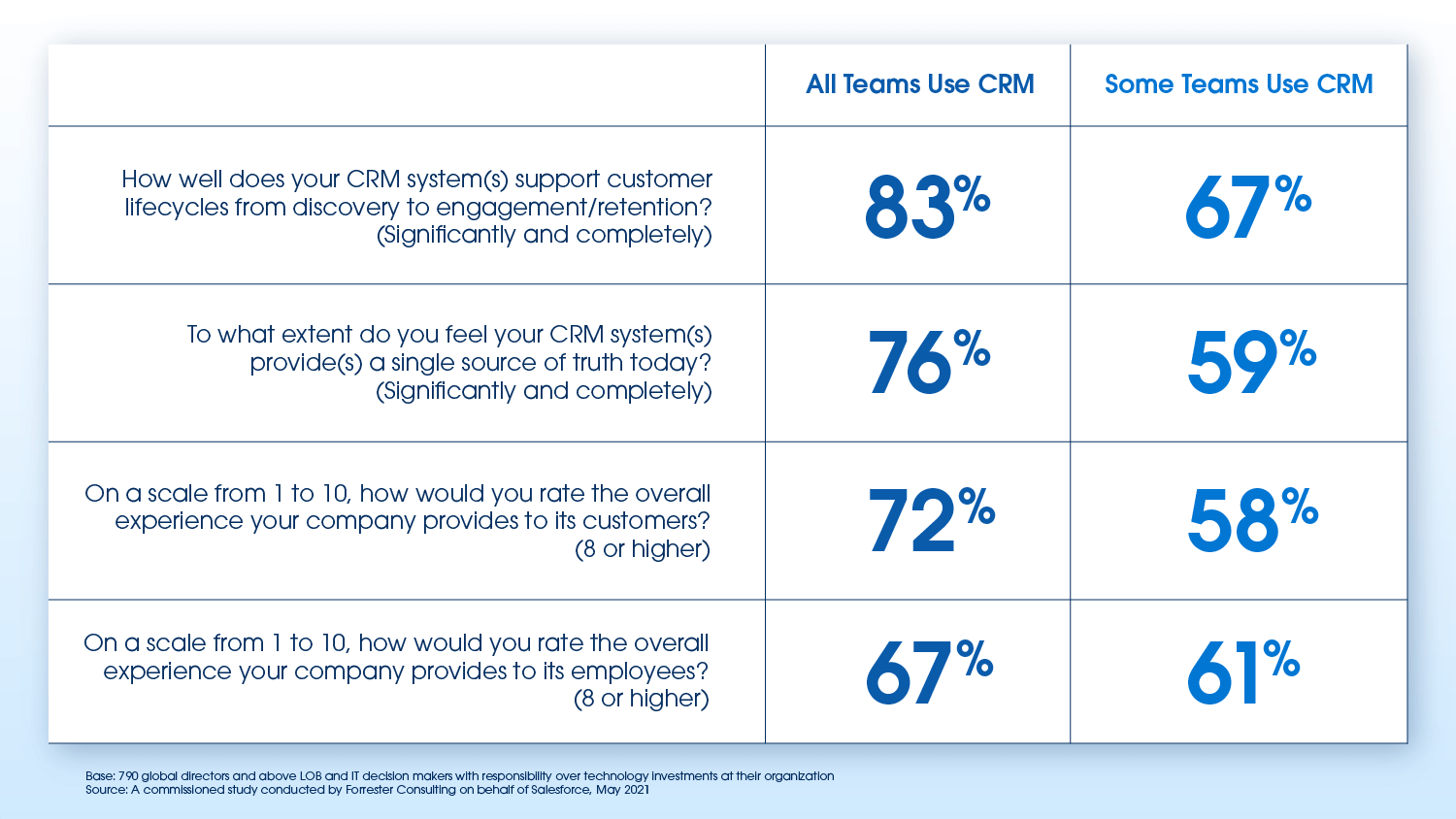Max Out Your CRM: State of CRM Research Has 8 Tips and Insights To Help



Read critical insight about the state of CRM technology – what’s working, what’s not – from a research survey of nearly 800 executives and 1500 employees in 15 countries.
It should come as no surprise that at Salesforce, we live and breathe CRM – customer relationship management. Acceleration of digital adoption has dramatically escalated the importance of relationships – the “R” in CRM – like never before. This is why we thought it was time to survey nearly 800 business decision makers and 1,500 employees worldwide to ask them about the current state of CRM.
Over the past 20 years of my career, I’ve analyzed the digital economy, enterprise technology, and the evolution of customer behaviors. I’ve also worked with some of the most innovative companies trying to excel against mounting disruption. Believe me when I tell you: teams and companies aren’t using CRM technology to its full potential as the engine for customer-centered growth. Not by a long shot, according to The State of CRM, commissioned research conducted by Forrester Consulting on behalf of Salesforce.
The research surveyed executives, team managers, and individual contributors across marketing, sales, commerce, service, finance, and IT. They helped us to understand how teams use CRM today and how companies can maximize their use of CRM technology to grow with resilience in an ever-evolving business landscape.
Read The State of CRM
Get insight into what’s driving CRM for 2021 – and what’s critical for your business’s evolving future.



Research suggests that even as customer expectations, market dynamics, and technologies have rapidly evolved, the way companies use CRM systems is not keeping up with the times. CRM use has, in fact, largely plateaued over the past couple years.
Our survey identified eight key insights to guide companies toward relationship-driven innovation and growth through the adoption of a next-generation CRM platform strategy.
1. Security and work-from-anywhere connectivity are paramount
In a similar commissioned survey conducted by Forrester Consulting on behalf of Salesforce in January 2020, Make CRM The Foundation Of Your Customer-Obsessed Strategy, low total cost of ownership was the most important criteria for decision makers evaluating CRM technology.
We’ve seen a sharp shift in priorities. According to The State of CRM, now only 26% of survey respondents said total cost of ownership is an important consideration, versus 51% for trust and security, and 47% for work-from-anywhere connectivity. This shift speaks in part to market conditions (hello, global pandemic) that have precipitated new priorities, but also to the maturity of the CRM systems marketplace. Secure, flexible, and resilient systems support improved value. This shifts the conversation from total cost of ownership to the positive value of opportunity.
2. Look to your CRM to become more resilient
A key research finding was learning how critical an organization’s CRM system is for supporting business resiliency. The majority of executives (57%) reported struggling to maintain good customer experiences (CX) with the shift to remote work because their CRM system/s were not well-integrated or accessible. Employees can’t easily access the tools they need to maintain the same level of customer engagement.
Employees tend to agree with the difficulty of creating good CX remotely. They reported struggling with information access challenges (40%), productivity challenges (49%), and communicating and coordinating effectively with colleagues (54%).
With well-integrated, easy-to-access (think cloud-based) CRM systems, employees are better able to navigate a flexible workplace and create great customer experiences. With enhanced workforce resiliency, executives can more easily adapt go-to-market strategies to pivot during times of change or uncertainty.
3. CRM isn’t just for sales and service teams
Current research indicates that collecting basic account information still tops the list of uses for CRM. But we now see a digital-first approach to sales, service, and marketing as the second core use case. The jump from CRM as a means of engaging customers to CRM for creating a connected customer experience across touchpoints is a critical shift.
Similarly, 81% of executives said that in the next three to five years, they expect CRM system usage to expand beyond sales and service/support. We’re seeing a spike in companies using their CRM to execute complete digital commerce transactions.
Though most organizations still use CRM systems for fundamental processes, we see a rising trend toward using CRM throughout the customer lifecycle for all teams. In fact, 62% said insights from their CRM system(s) are used by more teams across their organization beyond traditional users such as sales, marketing, and support.
4. Fragmented technology and data continue to hinder customer centricity
Seventy-three percent of survey respondents said CRM is fragmented at their organization, with some or all departments using their own CRM. A whopping 34% (one in three) said each department has its own CRM system.
This CRM fragmentation exacerbates data and organizational silos. It makes it more difficult for employees to find and use the information they need to enable more connected customer experiences. And when data is scattered across systems, it’s harder to achieve a consistent enterprise view of customer and prospect data to inform decision making. Almost 60% agree that these silos negatively impact the quality of customer and prospect experiences.

5. A single source of truth remains elusive
A single, reliable source of customer information creates personalized CX across the entire customer lifecycle. But when the average enterprise has data in over 800 applications, and just 29% of them are connected, a single source of truth about your customers can feel like an uphill battle.
Ninety percent of executives would find value (some, significant, or indispensable) in a single source of truth about their customers. Unfortunately, only 32% have this view today. That said, 69% of executives said their organizations increasingly use their CRM as that single source of customer information.
Employee perspectives are similar, if not slightly more dire. Just 27% of employees said they have a complete single source of truth, and 94% believe it would be of value (some, significant, or indispensable).

A single source of truth is the ultimate goal of customer relationship management, but it’s only possible with a centralized, scalable data and integration strategy.
Data must be in the right place and format for employee access, and they need the right skills and training to interpret and use that data to inform decisions and workflows. In fact, 72% of executives reported that improving the data skills of customer-facing employees is their top employee priority over the next 12 months. Employees agree.
6. Employees want better training and adoption of CRM to be changemakers
Technology alone won’t solve business problems; your people are the real changemakers, and they need the right tools and knowledge. Adoption, training, and change management are critical pieces of CRM deployment and your employee experience (EX). When employees don’t know how to use the CRM, or understand the value CRM can bring to their daily workflows, success and ROI will always remain out of reach.
Fifty-three percent of employees surveyed agreed they need better training and onboarding to use their CRM system. Fifty-seven percent also expressed that they were unable to maintain their customer engagement levels during the shift to remote work because their CRM systems are not well integrated across teams. And because not all departments use the same systems, they can’t easily share information.
These challenges aren’t just bad for your employees’ day-to-day experience; they’re bad for business.
- Sixty-two percent of employees noted that a more effective or advanced CRM system – one that’s well-integrated and used across teams – would help them create more value for the organization.
- This includes higher-volume or higher-value sales, improved customer satisfaction, improved customer loyalty, and more effective cross-sell and upsell opportunities.
- Similarly, 57% said it would help them have better interactions with customers to improve their satisfaction.
- One in two said an advanced CRM system would help them be more productive.
All of these improvements could translate to higher revenue and/or cost-savings. According to research by Salesforce, companies that prioritize EX to deliver a premium CX achieve 1.8 times faster revenue growth.
7. CX and EX improve as teams adopt shared tools
Customers expect employees to have a full understanding of who they are, their value to the organization, and where they are in their journey.
When all teams across an organization use CRM during the customer lifecycle, they’re 14% more likely to provide exceptional CX to their customers. By embedding CRM systems across all departments, teams, and processes, organizations can make it easier for their customer-facing teams to have actionable data to help them build memorable experiences.

To ensure CRM system/s are usable and effective across teams, unify CRM applications and support role-based views to ensure customers receive the experiences they expect. Unlock customer data from your systems and second- and third-party sources to build out a more holistic picture of each customer. And extend CRM with marketplace applications to support the customer’s full journey.
8. Artificial Intelligence (AI) will lead the future of CRM
This new generation of CRM technology connects data across departments. It also supports automation to offload repetitive actions and focus employees on more impactful customer interactions.
Nearly 50% of executives noted that they plan to invest in AI-powered recommendations that help employees with day-to-day processes. On top of that, 46% of executives plan to invest in AI to automate customer/prospect outreach. By 2023, 79% of organizations said they will be using AI-powered automation to enable easier customer/prospect engagement, and 78% will be using AI-powered automation to relieve employees of day-to-day processes.
Employees also look to AI to help them be more productive: 43% of surveyed employees said AI that provides deeper insight and proactive recommendations would make their CRM system more effective.
As you’re building your CRM roadmap, prioritizing automation and AI-powered workflows can help users through the best actions and conversations, and focus teams on work that matters most.
This is the time to underscore the “R” in CRM to unify businesses around the evolving customer and employee. Plugged-in companies are starting to tap into a new generation of CRM use and strategy that connects data across departments to automate processes, drive personalization, and support anytime, anywhere productivity. Research tells us that organizations that prioritize consistent use of CRM systems across teams, better training for customer-facing employees, and enhanced automation maximize the power of their CRM to deliver greatest business value. And they are also more resilient organizations in the face of massive disruption or change.
Read The State of CRM research study
Learn what executives and employees from marketing, service, sales, commerce, finance, and IT in 15 countries said about the evolution of CRM technology.




























